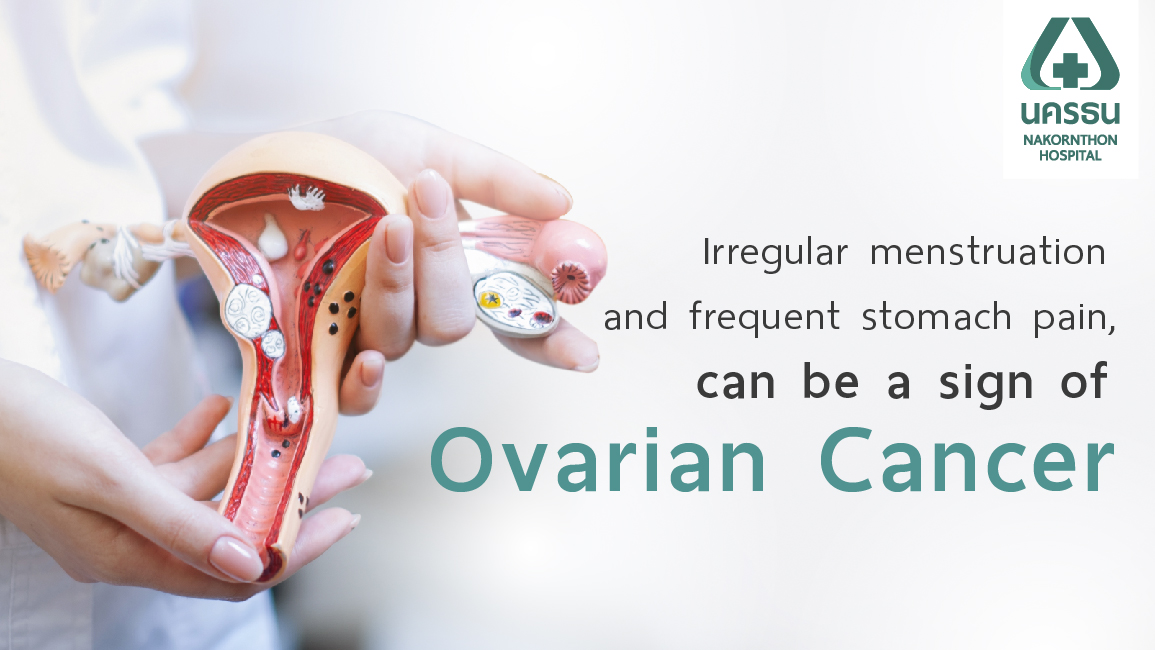Ovarian Cancer Stages
Center : Women Health Center

When it comes to cancer in women, many think of cervical cancer or breast cancer, but there is another type of cancer that is also very common but may not be well known, "ovarian cancer." It is more common in families where ovarian cancer has already occurred, and there are also risk factors in women who use ovulation stimulants. Therefore, women should be screened regularly for abnormalities that could indicate ovarian cancer.
Table of Contents
- What is Ovarian Cancer?
- What Causes Ovarian Cancer?
- How are Ovarian Cancer Stages Determined?
- What are the Stages Ovarian Cancer?
- Symptoms of Ovarian Cancer
- Treatment for Ovarian Cancer in Each Stages
- Ovarian Cancer Stages Conclusion
- Why must come to Nakornthon?
- Free Online Consultation with a Specialist
What is Ovarian Cancer
Ovarian cancer is the second most common cancer of the female reproductive organs after cervical cancer and the sixth most common cancer in Thai women. Over the lifetime of a typical woman who has no family history of the disease, the risk is 1.4%, which means that 1 in 70 women will develop ovarian cancer. If there is a risk, such as a hereditary disease, the risk increases.
What Causes Ovarian Cancer?
The cause is largely unknown, but there is one gene that has been shown to be relevant and increase the risk.
- Brca1/BRCA2 gene group causes ovarian cancer and/or breast cancer, such as women with BRCA 1 gene, the risk increases from 1.4 percent to 40-60 percent.
- Lynch syndrome causes cancer in the genital system, such as: Endometrial cancer Ovarian cancer
- Bowel cancer and urinary tract cancer
- In this group of people, there is usually a person in the family who has such cancer.
- However, nowadays, in cases of ovarian cancer and endometrial cancer, there is often a risk test to lead to family monitoring and affect the choice of medications.
- There is endometrial hyperplasia.
- It used to be irradiated in the pelvic area.
How are Ovarian Cancer Stages Determined?
There are 4 stages of ovarian cancer. Determining the stage usually requires surgery and a biopsy for pathological examination to identify the cell type, but before surgery, an examination is performed to formulate a treatment plan.
- Background checkup and physical examination
- Internal or rectal examination. Early detection of precancerous lesions
- Ultrasound examination is useful in the early diagnosis of ovarian cancer and is sensitive to detecting nodules.
- Blood tests for tumor markers including CA-125 (cancer antigen 125) and HE4 (human epididymal protein 4) combined with ultrasound to increase accuracy, but the sensitivity of the test is not sufficient to be used as a screening method today.
- Radiological diagnosis, such as computed tomography Computed tomography (CT scan) or electromagnetic resonance imaging Magnetic resonance imaging (MRI) helps in diagnosing and monitoring the spread of the disease.
- Laparoscopes are used to detect pelvic tissue and collect samples of tumors for pathological diagnosis.
- The main treatment usually begins with surgery, but if it is found to be a metastatic stage, the doctor may start with chemotherapy to reduce the lump size, followed by surgery.
What are the Stages Ovarian Cancer?
Ovarian cancer generally has four stages, but that doesn't mean that stage 4 patients are the last, as follows
Stage 1: Ovarian Cancer
Cancer cells are regularly found in one or both ovaries or fallopian tubes, and the cancer cells are scattered only in the ovaries. It has not spread if a regular internal examination is done, it is more likely to be found at this stage than in someone who has never been examined at all.
Stage 2: Ovarian Cancer
Periodically, cancer cells are found in one or both ovaries or fallopian tubes and have spread to surrounding tissues. However, the ovaries remain in the pelvic mucosa, which is also at a less detectable stage because there are no symptoms at all.
Stage 3: Ovarian Cancer
This is the stage when cancer cells are found in one or both ovaries or fallopian tubes and the cancer cells have spread to the upper peritoneum or nearby lymph nodes. It is the most commonly detected stage because the abdomen enlarges so rapidly that this disorder is noticeable accumulation of fluid in the stomach, and tightness in the abdomen, but the weight decreases.
Stage 4: Ovarian Cancer
It is the stage when cancer cells are found in the ovaries or 1 fallopian tube or both and it is the stage when cancer cells have spread to other parts of the body such as the liver, lungs, etc.
Symptoms of Ovarian Cancer
Ovarian cancer is different from other cancers such as cervical cancer or endometrial cancer, where there are symptoms such as abnormal bleeding from the vagina that may bring patients to the doctor at an early stage. However, early-stage ovarian cancer is usually asymptomatic or vague, such as: indigestion, bloating, flatulence, discomfort in the abdomen, easily gets full while eating. The most common symptoms that bring patients to the doctor include abdominal bloating, distension due to fluid in the stomach or lumps so large that they press on other organs in the stomach. In early-stage patients (stage 1-2), an ovarian tumor is often accidentally discovered during annual checkups or ultrasounds for other reasons.
Initially, if you have any of these symptoms. It is recommended to see an obstetrician-gynecologist for examination for refilling.
- Loss of appetite
- Nausea and vomiting.
- Weight gain or decrease for unknown reasons
- Frequent urination.
- Indigestion, flatulence.
- Feeling tired for unknown reasons
- Diarrhea or chronic constipation.
- Feeling abdominal pain or pelvic pain
- Abnormal vaginal bleeding
- Uncomfortable feeling in the abdomen.
- Feel full faster after eating.

Treatment for Ovarian Cancer in Each Stages
Treatment for ovarian cancer will depend on the type of cancer, the stage of the disease, the age of the patient, the need to have children.
- Surgery - Most common is hysterectomy and both ovaries, and lymph nodes and peritoneum according to where the cancer usually spreads, or remove the cancerous lump as much as possible, but if the patient is young and still wants to have children, it can be done in early cancer stage and in some cells, leaving the uterus and ovaries intact.
- Chemotherapy is the use of drugs to kill cancer cells. It is used in the early stages with lethal cell types, in late stages and when cancer recurs.
- Radiation therapy Is rarely used for ovarian cancer; it uses radiation to kill cancer cells and shrink the tumors. Radiation can be delivered from outside the body or directly into the body and can be used as a topical treatment.
- Targeted therapy is a drug that acts specifically on cancer cells by interfering with signaling related to the growth and spread of cancer cells, resulting in high therapeutic efficacy and fewer side effects on normal cells than chemotherapy. In ovarian cancer, it is often used in combination with chemotherapy.
The success of the treatment will depend on the stage of the cancer, cell type and hereditary characteristics.
Ovarian Cancer Stages Conclusion
If you have such abnormalities or suspect that you are at risk of developing ovarian cancer, you should see your doctor immediately for advice and a thorough diagnosis before it is too late. This is because if it is detected early, it cannot be saved. Timely treatment increases the chances and effectiveness of treatment. Although ovarian cancer is a rare disease, regular screening helps to detect abnormalities in the body early, without having to wait until the disease progresses and symptoms appear.
Why must come to Nakornthon?
Women Health Center offers comprehensive health care services for women of all ages; from health examination to diagnosis, prevention, treating women related diseases. All by specialists in the field, providing consulting services with technology to help diagnose diseases; in order to increase safety and treatment efficiency. It is done with understanding and concern for women health.
Free Online Consultation
Article of Women Health Center






